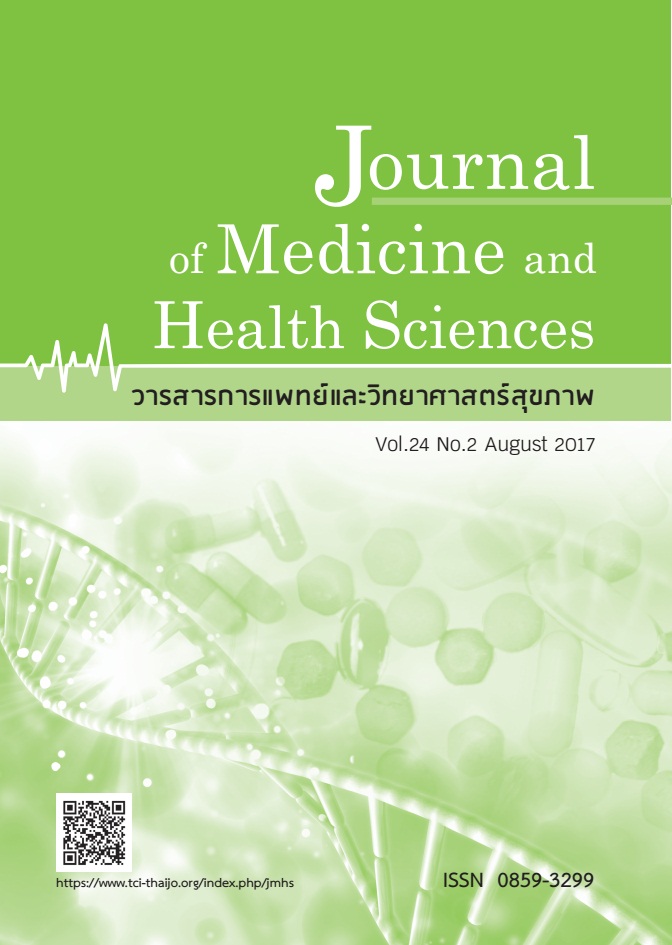การควบคุมคุณภาพภายในรายวิชาโสต ศอ นาสิก ด้านการประเมินผลการศึกษา ของปีการศึกษา 2558(Internal quality control of student assessment in otolaryngology academic year 2015)
Keywords:
การควบคุมคุณภาพ เกณฑ์ประเมินคุณภาพหลักสูตร การประเมินผลการศึกษา ค่าขนาดอิทธิพล/quality control, curriculum assessment criteria, student assessment, effect size.Abstract
บทคัดย่อ
ปีการศึกษา 2558 รายวิชาโสต ศอ นาสิก ได้รับนโยบายจากคณะแพทยศาสตร์ ให้จัดส่งนิสิตส่วนหนึ่งแยกจาก ศูนย์การแพทย์สมเด็จพระเทพรัตนราชสุดา สยามบรมราชกุมารี มหาวิทยาลัยศรีนครินทรวิโรฒ ไปเรียนที่ ศูนย์การแพทย์ปัญญานันทภิกขุ ชลประทาน มหาวิทยาลัยศรีนครินทรวิโรฒ เพื่อเป็นการควบคุมคุณภาพภายในการศึกษาที่ต้องมีความเสมอภาคตามเกณฑ์ประเมินหลักสูตรของ Asean University Network version 3 และเกณฑ์ประเมินคุณภาพระดับหลักสูตร คณะกรรมการการอุดมศึกษา ฉบับ พ.ศ.2557 รายวิชาจึงทำการศึกษาเพื่อควบคุมกระบวนการในส่วนการประเมินผลการเรียนรู้ นำคะแนนที่ได้จากการประเมินในทุกประเภทการสอบที่ได้จากทั้งสองศูนย์การศึกษาถูกนำมาคำนวณหาค่าขนาดอิทธิพล คะแนนประเภทมีค่าขนาดอิทธิพลสูงกว่า 0.80 ได้แก่ คะแนนเจตคติ 2.293 และคะแนนสอบตรวจร่างกาย 1.639 ในส่วนคะแนนรวมค่าขนาดอิทธิพลเท่ากับ 0.868 ถือว่าอยู่ระดับสูงเช่นกัน ดังนั้นการพิจารณาเกรดจึงจำเป็นต้องกระทำแยกกลุ่มกัน จากนั้นจึงทำการตรวจสอบผลการตัดเกรด ผลค่าเฉลี่ยเกรดกลุ่ม ศูนย์การแพทย์สมเด็จพระเทพฯ และกลุ่ม ที่ ศูนย์การแพทย์ปัญญานันทภิกขุฯ เท่ากับ 2.7968 และ 2.7903 ตามลำดับ เมื่อคำนวณได้ค่าขนาดอิทธิพลเกรด เท่ากับ 0.0086 จากนั้นหาความสอดคล้องของเกรดที่ได้เปรียบเทียบกับเกรดเฉลี่ยปี 4 ที่ได้ของแต่ละคนด้วยการหาค่าสัมประสิทธิ์สหสัมพันธ์แบบเพียร์สันเท่ากับ 0.521 จึงสรุปได้ว่าผลการตัดเกรดรายวิชาโสต ศอ นาสิกเป็นไปอย่างเสมอภาคและเหมาะสมสอดคล้องกับเกรดเฉลี่ยปี 4
Abstract
In 2015, Faculty of Medicine Srinakharinwirot University launched the policy to divide groups of students from HRH Princess Mahachakri Sirindhorn Medical Center (MSMC) to learn Otolaryngology at Panyananthaphikkhu Chonprathan Medical Center (PCMC). To make quality control about student assessment process to ensure validity, reliability and fairness of student assessment according to Asean University Network version 3 criteria and internal curriculum assessment criteria from Office of higher education commission. This study compares each type of scoring between both institutes to evaluate effect size. The results show three scoring that the effect size more than 0.8 including Attitude score 2.293, Physical examination score 1.639, and total score effect size is 0.868 that reflected unequal of scoring and suggest to be grading each institute separately. Furthermore, after grading, the average grade of MSMC and PCMC group is 2.7968 and 2.7903 respectively. The effect size of grading is 0.0086. At the last, all individual student grades are calculated to compare with average 4th-year grade as the Pearson coefficient is 0.521. With this result, the grading of Otolaryngology is fairness and high correlation with their average 4th-year grade.



